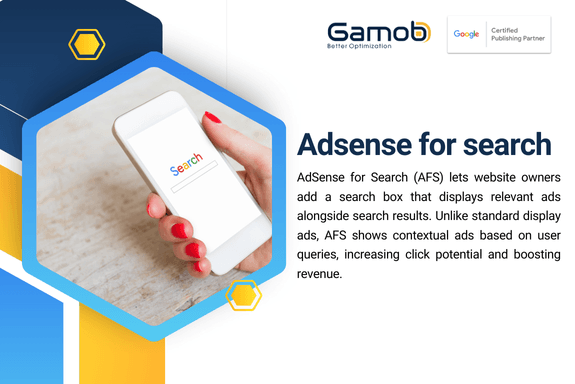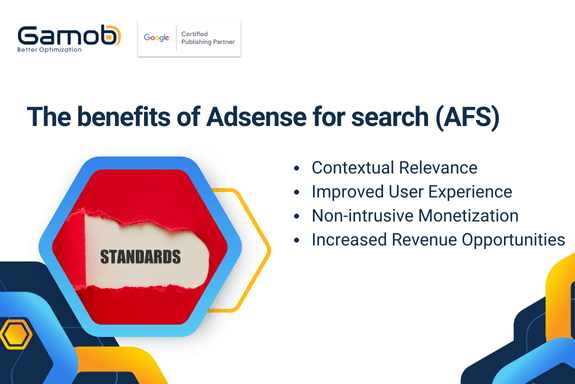Adsense For Search
Website traffic is stable, so how to increase website revenue?
Tracy Nguyen
February 25, 2025

Subscribe to receive the latest blog posts to your inbox every week.
By subscribing you agree to with our Privacy Policy.
In today’s digital age, having a steady stream of traffic to your website is an achievement in itself. However, traffic alone isn’t enough to build a sustainable revenue model. To truly maximize your online revenue, you need to leverage the right monetization strategies effectively. One such strategy is Google’s AdSense for Search (AFS).
If you're already familiar with AdSense and its regular ad types, you're halfway there. But if you’re looking for a way to enhance your website revenue using a more tailored approach, integrating AdSense for Search (AFS) can be a game changer. This article will walk you through how to increase your website's revenue by effectively utilizing AFS, offering insights on its setup, best practices, and strategies for optimization.
What is Google AdSense for Search (AFS)?
Before diving into how AFS can help you boost your website revenue, let’s clarify what AdSense for Search is.
AdSense for Search (AFS) allows website owners to add a customizable search box to their site that lets users search for content. When visitors use the search feature, relevant ads are displayed alongside the search results. For each click on these ads, you earn a share of the revenue.
Unlike standard display ads that show up on your site, AFS works with search-specific ads. It combines the functionality of a search engine with the monetization potential of Google Ads. When a user searches for content, the ads are contextual, meaning they’re closely related to the search query, increasing the chances of clicks and improving your earnings.

Why Use AdSense for Search?
There are several reasons why integrating AdSense for Search into your website can be beneficial:
- Contextual Relevance: AFS displays ads relevant to the user’s search, which increases the likelihood of clicks.
- Improved User Experience: By offering a search feature, you improve your website’s usability and make it easier for users to find content, which can lead to more time spent on your site.
- Non-intrusive Monetization: Unlike banner ads that may disrupt the user experience, the search ads appear naturally within the search results, making them less obtrusive.
- Increased Revenue Opportunities: With more targeted ads, users are more likely to click, increasing the potential for higher earnings from search traffic.

How to Set Up AdSense for Search on Your Website
Setting up AFS is a straightforward process. Here’s a step-by-step guide to help you get started:
- Sign Up for AdSense: If you don’t already have an AdSense account, you’ll need to sign up. Ensure your website complies with AdSense's policies to avoid any issues.
- Create a Search Engine: After logging into your AdSense account, navigate to the ‘Ads’ section and click on Search. You’ll be prompted to create a custom search engine for your site.
- Customize the Search Box: Google allows you to customize the appearance and functionality of your search box. You can choose its size, color, and style to match your site’s design. Customizing the look helps make it blend seamlessly with your content.
- Integrate the Code: After customizing the search box, Google provides you with a snippet of code. You simply need to place this code on the pages where you want the search feature to appear.
- AdSense Integration: Once the search box is set up, AFS will automatically display relevant search ads when users perform a search. You can also monitor the performance of the ads in your AdSense account.
Best Practices to Increase Website Revenue with AFS
Now that you’ve got AFS up and running, let’s look at some strategies to optimize its potential and increase your website revenue.
1. Place the Search Box Prominently
The placement of the search box plays a huge role in user engagement. If the search box is buried in a non-visible spot, users may never discover it. To drive traffic to the search feature, place it prominently at the top of your pages or in a sidebar that’s easy for users to find.
Moreover, ensure that the search box is clearly labeled and intuitive, helping visitors understand its purpose. If people can easily find what they’re looking for, they’re more likely to interact with the search, which in turn increases the likelihood of ad clicks.
2. Optimize the Search Experience
For AFS to be effective, the search results should be highly relevant to what users are looking for. The better the search results, the higher the chances that visitors will click on ads.
- Ensure Content Quality: Ensure that the content you are offering is high-quality and relevant to the keywords people might search for. This improves the chances of displaying the most relevant ads and gives users a reason to engage.
- Refine Search Filters: If you have a large website with various types of content, consider adding filters or categories to help users narrow down their search results, making it easier for them to find exactly what they want.
3. Promote the Search Feature
Don’t just rely on organic traffic to find your search bar. Actively promote it across your site. Consider adding a call-to-action (CTA) near your main content or in pop-ups encouraging visitors to use the search feature. The more users engage with your search box, the more opportunities there are for ad clicks.
4. Use Customizable Search Ads
Google allows you to customize the appearance of the search results and ads. Try experimenting with different formats of ads to see which ones perform the best. For example, you can use text ads, image ads, or even shopping ads based on your site’s content.
Additionally, consider optimizing your search results page by integrating ad types that blend well with your design, making them more likely to catch users’ attention without disrupting the flow of your content.
5. Focus on High-Value Keywords
To increase your earnings, focus on creating content that targets high-value keywords. These are terms that advertisers are willing to pay more for due to the competition or the high ROI they offer. Targeting these keywords will ensure that your search results are more likely to display higher-paying ads.
Use tools like Google Keyword Planner or other SEO tools to identify high-traffic, high-conversion keywords in your niche. Ensure your content is optimized for these terms.
6. Optimize for Mobile
A large portion of internet traffic comes from mobile devices, so ensuring that your AFS setup is mobile-friendly is crucial. Optimize your search box and results page for mobile screens to ensure that visitors have a seamless experience regardless of the device they use. Google also favors mobile-optimized sites in search rankings, so improving your mobile experience can boost both traffic and revenue.
7. Track Performance and Make Adjustments
Monitor the performance of your AFS implementation regularly. AdSense provides detailed reports on the performance of your search ads, including metrics like impressions, clicks, and revenue. Pay attention to these insights and adjust your strategy accordingly. For example, if certain types of ads are underperforming, you may need to refine your targeting or change the ad formats.
Additional Revenue Streams to Consider Alongside AFS
While AdSense for Search is a powerful tool for monetizing your website, don’t forget about other revenue opportunities. Consider combining AFS with other AdSense ad types, such as display ads and video ads, to further increase your revenue potential.
- Display Ads: These are the typical banner or sidebar ads that display on your site. They can be placed in areas where they’re likely to grab attention, such as at the top or bottom of pages.
- Video Ads: If you have multimedia content, video ads can be an excellent way to boost earnings. These ads are highly engaging and tend to have higher CPMs (cost-per-thousand-impressions).
You might also want to explore affiliate marketing, where you promote third-party products or services on your site and earn commissions for successful sales. These additional revenue streams can provide a nice complement to your AFS income.
AdSense for Search (AFS) is a great tool to increase your website’s revenue, especially if you already have steady traffic. By setting up a well-placed, customized search box and optimizing the search results for relevance, you can create more opportunities for ad clicks and ultimately boost your earnings.
With continuous monitoring and adjusting your strategy based on performance metrics, you can significantly improve your site’s monetization potential. Always remember that a great user experience and valuable content are at the core of successful monetization, so make sure your website provides both.
Instead of researching and deploying AFS, you can choose Gamob as your AFS development partner. Gamob is Google Certified Publishing Partner (GCPP) that empowers over 10,000 publishers helping them deliver expert solutions in Product and User Acquisition Consultancy, Revenue & Inventory Optimization, and Inventory Quality Assurance. Our mission is to boost publishers' and ad networks' success, ensuring quality, efficiency, and sustainable growth through trusted, innovative partnerships.